Books by Dr. Lavkush Dwivedi
Educreation Publishing, 2018
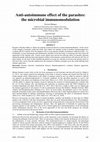
Parasites with their ability to vibrate our immune system are known as potent immunomodulators. I... more Parasites with their ability to vibrate our immune system are known as potent immunomodulators. In the course of life struggle of parasites within host body, they induce our immune system to produce immunosuppressive cytokines like IL-4 and IL-10 by the immune cells to create parasite friendly environment within host body. Co-incidentally, several autoimmune and inflammatory disorders of the host body, if existed get also relax from self aggression of the immune cells. Various recent reports have proven the relieving effects of parasitic infection among the people suffering from discriminative failure of the immune system between self and non-self. Few of those reports, on the basis of their detailed mechanism of action are critically reviewed in the present article to find out if they can be clinically employed for the treatment of billions of people across the world suffering from immune aggression.

India is a great repository of variety of medicinal plants. Presence of nearly 8000 species of me... more India is a great repository of variety of medicinal plants. Presence of nearly 8000 species of medicinal plants has proved it one of the richest genetic resources of the world. Moreover, about 45000 plants species i.e. 12 % of global wealth of flowering plants are reported to occur in India, out of which nearly 33% are endemic. However, the use of plants as medicine is as old as human civilization and reported from 400-500 BC but, in the last couple of decades, global demand of herbal medicine has led to a quantum jump with 7% annual growth rate. However, several of them due to lack of scientific attention and acknowledgement are yet to be evaluated. Hence, an attempt is made in the present book to systematically compile the taxonomic, therapeutic and other detail of 52 important medicinal plants of India, so that they can be known, conserved, cropped and further researched for their maximum therapeutic utilization.

Today, the rapid scientific and technological advancements have caused several health risks along... more Today, the rapid scientific and technological advancements have caused several health risks alongside the comforts in life. Human health risk assessment is a process which evaluates such health issues in a logical and systemic manner to bring them at acceptable level. However, many human health risk assessment and management (HHRAM) approaches are developed and employed in developed countries, but due to different orientation most of them are found incompatible for developing countries. Therefore, in the present book, an investigation to design and develop a predictive in-silico tool for HHRAM and ehealth survey of developing countries' population is described. The book may be useful into developing the HHRAM program at individual to community (Provincial/National/International) level by various regulatory agencies and research organizations. Hence the students, Researchers, regulatory agencies (state/provincial) and most importantly every common man may take the revenue of it.
Papers by Dr. Lavkush Dwivedi

Madhucalongifolia member of the family Sapotaceae was studied for its immunomodulatory activity o... more Madhucalongifolia member of the family Sapotaceae was studied for its immunomodulatory activity on albino mice in the present study. The ethanolic extract of the plant (EEML) was administered at the dose of 100 and 200mg/kg body weight in the treated groups III and IV. The antibody titre value, DTH response and effect on myelosuppression were checked against the control group I and cyclophosphomide induced myelosuppressed group II. The significant (p<0.01) increase in antibody titre value and DTH response in group III & IV was reported as a sign of its stimulating effect on humoral and cell mediated immunity respectively. Moreover, the restoration of Total Leukocyte Count (TLC) and Differential Leukocyte Count (DLC) to normal level in EEML treated group III & IV as compared to cyclophosphomide treated group II has shown it ameliorating effect on myeloid regeneration too. Hence, the M. longifolia with the significant immunostimulatory activity on both the specific and non-specific...

Parasites with their ability to vibrate our immune system are known as potent immunomodulators. I... more Parasites with their ability to vibrate our immune system are known as potent immunomodulators. In the course of life struggle of parasites within host body, they induce our immune system to produce immunosuppressive cytokines like IL-4 and IL-10 by the immune cells to create parasite friendly environment within host body. Co-incidentally, several autoimmune and inflammatory disorders of the host body, if existed get also relax from self aggression of the immune cells. Various recent reports have proven the relieving effects of parasitic infection among the people suffering from discriminative failure of the immune system between self and non-self. Few of those reports, on the basis of their detailed mechanism of action are critically reviewed in the present article to find out if they can be clinically employed for the treatment of billions of people across the world suffering from immune aggression.

Human Health Risk Assessment & Management (HHRAM) is a systemic process to identify and character... more Human Health Risk Assessment & Management (HHRAM) is a systemic process to identify and characterize the nature and concentration of human health risks and possible restoration of health by scientific and technological methods. Such approaches are developed and communicated through internet in western countries to predict and manage the health risks of their own population. But due to entirely different circumstances they are found unfit for the country like India where diversity is an emblem. Since, Internet penetration is at pace and being developing nation growing health risks may not be an exception in India also. Therefore a HHRAM approach addressing to Indian population was attempted to design and develop in the present investigation which could predict and manage the health risks online. Study completed in three phases (1) Preparation of online health risk assessment questionnaire (HRAQ) containing variables of our interest related to personal history, occupational health status, environmental and socio-economical status (2) Development of Database Management System (DBMS) to logically collect, retrieve and evaluate the collected data in computerized format (3) Designing and development of website (www.healthrisk.co.in) holding all the developed tools and other health related information for online survey and HHRAM. The health status inferences in addition to affordable mitigations are programmed to figure as risk report and produced to every end user at every assessment. MySQL, Microsoft office 2007, Hypertext Preprocessor (PHP) and Cascading Style Sheets (CSS) languages and application software were used for its development. More than 2000 individuals' consented data have been collected and evaluated so far.

Madhucalongifolia member of the family Sapotaceae was studied for its immunomodulatory activity o... more Madhucalongifolia member of the family Sapotaceae was studied for its immunomodulatory activity on albino mice in the present study. The ethanolic extract of the plant (EEML) was administered at the dose of 100 and 200mg/kg body weight in the treated groups III and IV. The antibody titre value, DTH response and effect on myelosuppression were checked against the control group I and cyclophosphomide induced myelosuppressed group II. The significant (p<0.01) increase in antibody titre value and DTH response in group III & IV was reported as a sign of its stimulating effect on humoral and cell mediated immunity respectively. Moreover, the restoration of Total Leukocyte Count (TLC) and Differential Leukocyte Count (DLC) to normal level in EEML treated group III & IV as compared to cyclophosphomide treated group II has shown it ameliorating effect on myeloid regeneration too. Hence, the M. longifolia with the significant immunostimulatory activity on both the specific and non-specific immune mechanisms holds great promises for being used as an immunomodulating agent. However, more in-depth studies of various other extracts of different parts of the plant may further explore its probability to be used as immunomodulatory drug for the management of infectious diseases.
The irreversible effects of modern therapies and increasing drug resistance have augmented our re... more The irreversible effects of modern therapies and increasing drug resistance have augmented our reliance on medicinal plants for herbal remedy against the deadly and infectious diseases.
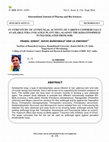
Keratophilic fungi, a type of dermatophytes cause infection to hair, glabrous skin and nails of h... more Keratophilic fungi, a type of dermatophytes cause infection to hair, glabrous skin and nails of human beings and animals. Soil is well known to be supporting the transient existence of them. The volatile plant oils have been of concern recently to develop a new antifungal agent. The present study attempts to evaluate four different commercially available Itra-Bella (Lonicera x bella zabel), Kewda (Pandanus odoratissimus), Rajnigandha (Polianthes tuberosa) and Mogra (Jasminum sambac) for their antifungal activity against the Aspergillus flavus, Trichophyton mentagrophytes, Trichophyton tonsurans, Trichophyton verrucosum, Epidermatophyton floccosum and Microsporum nanum isolated from soil. A few among the selected Itra were observed and were found to be showing better antifungal activity than existing antifungal drugs like Terbinafine, Itraconazole and Fluconazole (taken as control). The maximum effect was shown by Bella against T.tosurans with inhibitory zone of 47mm. The paper concludes that the Itra can be used as antifungal agent against prevalent keratinophilic fungi.
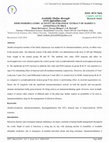
Madhucalongifolia member of the family Sapotaceae was studied for its immunomodulatory activity o... more Madhucalongifolia member of the family Sapotaceae was studied for its immunomodulatory activity on albino mice
in the present study. The ethanolic extract of the plant (EEML) was administered at the dose of 100 and 200mg/kg
body weight in the treated groups III and IV. The antibody titre value, DTH response and effect on myelosuppression were checked against the control group I and cyclophosphomide induced myelosuppressed group II. The significant (p<0.01) increase in antibody titre value and DTH response in group III & IV was reported as a
sign of its stimulating effect on humoral and cell mediated immunity respectively. Moreover, the restoration of Total
Leukocyte Count (TLC) and Differential Leukocyte Count (DLC) to normal level in EEML treated group III & IV as compared to cyclophosphomide treated group II has shown it ameliorating effect on myeloid regeneration too.
Hence, the M. longifolia with the significant immunostimulatory activity on both the specific and non-specific immune mechanisms holds great promises for being used as an immunomodulating agent. However, more in-depth
studies of various other extracts of different parts of the plant may further explore its probability to be used as immunomodulatory drug for the management of infectious diseases.
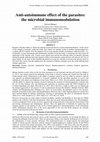
Parasites with their ability to vibrate our immune system are known as potent immunomodulators. I... more Parasites with their ability to vibrate our immune system are known as potent immunomodulators. In the course
of life struggle of parasites within host body, they induce our immune system to produce immunosuppressive
cytokines like IL-4 and IL-10 by the immune cells to create parasite friendly environment within host body. Coincidentally,
several autoimmune and inflammatory disorders of the host body, if existed get also relax from self
aggression of the immune cells. Various recent reports have proven the relieving effects of parasitic infection
among the people suffering from discriminative failure of the immune system between self and non-self. Few of
those reports, on the basis of their detailed mechanism of action are critically reviewed in the present article to
find out if they can be clinically employed for the treatment of billions of people across the world suffering from
immune aggression.
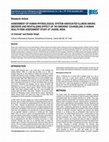
Quality of life is determined by the sound health behaviors. Whereas behaviors like smoking, toba... more Quality of life is determined by the sound health behaviors. Whereas behaviors like smoking, tobacco chewing and alcohol consumption persuade moderate to severe, acute and chronic illness of many vital organs of human body. Therefore, in the present study, a human health risk assessment questionnaire (HRAQ) based consented health survey of 2000 individuals of Jhansi city was done to distinguish the major biological systems generally punished by the smoking and narcotic habits. As a result, about 68% (n=739/1087) individuals among smokers in comparison to only 24% (n=218/913) among non-smokers were found unhealthy. In total 957 out of 2000 volunteers were assessed unhealthy. All volunteers were observed for illness related to Respiratory system, Nervous system, Cardio-vascular system, Teeth & Gums, Musculo-skeletal system, Gastrointestinal and Genitourinary system. The highest complaints (n=182) were recorded from Respiratory system while cases allied to Genito-urinary system were minimum. Interestingly, about 30% drop in quantity and intensity of illness was reported after dedicated counseling of individuals for passing the smoking free healthy life. So, at one hand where smoking leave a lethal impact on validity of body organs, at the same time proper and endured counseling of individuals for healthy and smoking free life can revitalize the health by some extent.

Rheumatoid Arthritis (RA) is a manifestation of body from multiple causes of weakened immune syst... more Rheumatoid Arthritis (RA) is a manifestation of body from multiple causes of weakened immune system, a developed internal allergic response to unknown allergens, hormonal factors, stress and other unknown factors. The present study was undertaken to determine the Anti-arthritic and Antiinflammatory property of Lactobacillus acidophilus as probiotics against Collagen induced arthritis (CIA) in wistar rat. CIA (100μl) was induced intradermally at several sites on the back. A dose of L. acidophilus 2 x 10 8 CFU/ml was administered orally after induction of arthritis i.e. on 7 th day. Dexamethasone was given as standard drug in the dose of 0.3-3.0 mg/kg body weight. Paw thickness was measured and scored regularly. After sacrifice, blood was withdrawn for haematological, biochemical and serological analysis. Histopathology of liver, kidney and ovary was also performed. Oral administration of Lactobacillus significantly decreased the serum ceruloplasmin level. Beneficial effects such as increased adhesive property shown by Lactic Acid Bacteria (LAB), increased haemoglobin content and RBC and decreased WBC counts were observed. High level of C' Reactive Protein was observed in arthritic control rats. However, L. acidophilus treatment significantly decreased CRP level. Standard Drug also reduced the CRP level. Similarly Rheumatoid factor was also decreased in LAB and standard drug group as compared to the control. In conclusion LAB has potent anti-arthritic property against and shown reduced level of RF and CRP in collagen induced arthritis in wistar rats.

Wheat (Triticum aestivum), belonging to poaceae family is a vital constituent of the human diet. ... more Wheat (Triticum aestivum), belonging to poaceae family is a vital constituent of the human diet. At the germinated stage, the leaves of wheat over 6-10 days are commonly called wheatgrass, it contain very good quantity of chlorophyll, which shows the structural similarity to haemoglobin molecule hence, known to play a significant role in blood deficiency diseases such as Thalassemia and myelotoxicity in cancer patients during chemotherapy. Moreover, wheatgrass has been reported as the richest source of vitamins, enzymes, minerals, aminoacids, trace elements, phytochemical components and a glycoprotein P4D1 etc. which can stimulate the repair of DNA and RNA in case of their damage. All of them collectively provide a good therapeutic potential against a broad range of ailments including chronic diseases. The recent researchers reporting its antioxidant, anti-arthritic, antihyperlipidemic or cardio-protective, anti-diabetic, anti-inflammatory and immunomodulatory activities have made this plant more valuable in herbal research. In the present review attempt is made to focus on the therapeutic potential of wheatgrass against the various chronic diseases.
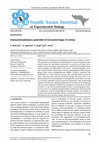
Medicinal plants having immunomodulatory properties provide an alternative potential to conventio... more Medicinal plants having immunomodulatory properties provide an alternative potential to conventional chemotherapy for a variety of diseases especially in relation to host defense mechanism. Curcumin one of major curcuminoids of Curcuma longa, reportedly possess several pharmacological properties including anti-inflammatory, anti-cancer, immunomodulatory activities. Curcumin blocks inflammatory enzymes cyclooxygenase (COX), lipooxygenase (LOX), matrix metalloproteinase (MMP). Curcumin suppresses the proliferation of a wide variety of tumour cells, including breast carcinoma, colon carcinoma, and renal cell carcinoma through cell cycle arrest. It induced apoptosis by downregulation of antiapoptotic protein (Bcl-2 and Bcl-xL). Curcumin modulates immune system by suppressing T-cells, proliferating number of B-cells and reducing proliferation of immature B-cell lymphoma cells. Curcumin treatment inhibited the production of cytokines (IL-8, MIP-1α, MCP-1, IL-1β, TNF-α) and dimerisation of TLR's. Immunoregulatory activity of curcumin is by inhibiting phosphorylation of IKKβ which ultimately leads to suppression of NF-κB (transcriptional activator protein). This activity of curcumin has renewed scientific interest in its potential to prevent and treat the diseases such as arthritis, allergy, asthma & cancer.









Uploads
Books by Dr. Lavkush Dwivedi
Papers by Dr. Lavkush Dwivedi
in the present study. The ethanolic extract of the plant (EEML) was administered at the dose of 100 and 200mg/kg
body weight in the treated groups III and IV. The antibody titre value, DTH response and effect on myelosuppression were checked against the control group I and cyclophosphomide induced myelosuppressed group II. The significant (p<0.01) increase in antibody titre value and DTH response in group III & IV was reported as a
sign of its stimulating effect on humoral and cell mediated immunity respectively. Moreover, the restoration of Total
Leukocyte Count (TLC) and Differential Leukocyte Count (DLC) to normal level in EEML treated group III & IV as compared to cyclophosphomide treated group II has shown it ameliorating effect on myeloid regeneration too.
Hence, the M. longifolia with the significant immunostimulatory activity on both the specific and non-specific immune mechanisms holds great promises for being used as an immunomodulating agent. However, more in-depth
studies of various other extracts of different parts of the plant may further explore its probability to be used as immunomodulatory drug for the management of infectious diseases.
of life struggle of parasites within host body, they induce our immune system to produce immunosuppressive
cytokines like IL-4 and IL-10 by the immune cells to create parasite friendly environment within host body. Coincidentally,
several autoimmune and inflammatory disorders of the host body, if existed get also relax from self
aggression of the immune cells. Various recent reports have proven the relieving effects of parasitic infection
among the people suffering from discriminative failure of the immune system between self and non-self. Few of
those reports, on the basis of their detailed mechanism of action are critically reviewed in the present article to
find out if they can be clinically employed for the treatment of billions of people across the world suffering from
immune aggression.
in the present study. The ethanolic extract of the plant (EEML) was administered at the dose of 100 and 200mg/kg
body weight in the treated groups III and IV. The antibody titre value, DTH response and effect on myelosuppression were checked against the control group I and cyclophosphomide induced myelosuppressed group II. The significant (p<0.01) increase in antibody titre value and DTH response in group III & IV was reported as a
sign of its stimulating effect on humoral and cell mediated immunity respectively. Moreover, the restoration of Total
Leukocyte Count (TLC) and Differential Leukocyte Count (DLC) to normal level in EEML treated group III & IV as compared to cyclophosphomide treated group II has shown it ameliorating effect on myeloid regeneration too.
Hence, the M. longifolia with the significant immunostimulatory activity on both the specific and non-specific immune mechanisms holds great promises for being used as an immunomodulating agent. However, more in-depth
studies of various other extracts of different parts of the plant may further explore its probability to be used as immunomodulatory drug for the management of infectious diseases.
of life struggle of parasites within host body, they induce our immune system to produce immunosuppressive
cytokines like IL-4 and IL-10 by the immune cells to create parasite friendly environment within host body. Coincidentally,
several autoimmune and inflammatory disorders of the host body, if existed get also relax from self
aggression of the immune cells. Various recent reports have proven the relieving effects of parasitic infection
among the people suffering from discriminative failure of the immune system between self and non-self. Few of
those reports, on the basis of their detailed mechanism of action are critically reviewed in the present article to
find out if they can be clinically employed for the treatment of billions of people across the world suffering from
immune aggression.